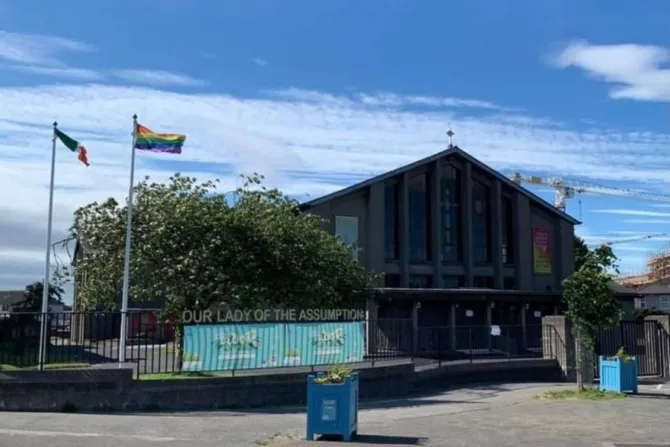Our Lady of the Assumption Catholic Church, Ballyfermot, Ireland, displays the LGBT rainbow flag/ Ballyfermot Assumption Parish/Facebook
A Catholic parish in Ireland has reluctantly taken down a rainbow LGBT “Pride” flag that was erected last week outside the church, after an intervention from the Dublin archdiocese.
Our Lady of the Assumption parish in Ballyfermot, near Dublin, last week flew both an Irish flag and a striped rainbow flag – a common symbol of “LGBT pride” – outside the parish, during the month of June which is celebrated as “Pride Month.”
The Archdiocese of Dublin last Friday asked the parish to remove the flag due to its policy against flying any flags on church grounds, except for national flags on appropriate occasions.
Father Adrian Egan, Parish Priest of Our Lady of the Assumption, apologized to “all those genuine people” who expressed confusion and hurt at the raising of the Pride flag, but also to “those who were hurt” by the flag’s removal.
In a statement to The Journal, the Irish Catholic Bishops’ Conference said: “On special occasions, only the Papal flag and/or the National flag, are permitted to be flown on church grounds in the Archdiocese of Dublin[.]”
Father Egan said in his Sunday homily June 20 that he approved the flying of the Pride Flag because of his desire to make the parish a “place of welcome for all.”
On June 14, Father Egan said that the parish council met and discussed June’s status as the month dedicated by the Church to the Sacred Heart of Jesus.
“We were also talking about how June has become a significant month for gay people, for gay men and women, and that there are lots of secular events and things going on in that regard during the month of June,” Father Egan said, adding that the parish council came to the conclusion that the image of the Sacred Heart represents a love that is “inclusive of everybody.”
The parish has some gay members, he said, who say they have been “hurt” by the language that the Church uses in its teaching on homosexuality. The parish council decided they wanted to send out a message that “God loves them,” Egan said.
The parish posted photos of the flag flying outside the parish on its Facebook page.
“Just an effort by a parish pastoral council to say to our gay brothers and sisters, ‘God loves you, your parish loves you, and you are welcome here’. Applies to all of you too!” an unsigned June 16 Facebook status from the parish’s page reads.
Egan said when the flag was displayed, he received many messages of “thanks and appreciation,” and also messages from “very good Catholic people” who were hurt and dismayed by the flag. He noted there were still other messages which were “aggressive and hostile and nasty.”
While the flag was flying, a group of Catholics reportedly gathered to pray the rosary across the road from the church. By Friday evening, Egan said the archbishop called to ask the parish to remove the flag.
“Am I in trouble? Probably,” Father Egan said.
“The flag is down, but the message of the banner is still out there, and it remains exactly the same. And I believe it reflects the Gospel.”
Pride Month is celebrated widely throughout June each year, with parades, parties and concerts celebrating the LGBT lifestyle.
The Catechism of the Catholic Church paragraph 2358 teaches that persons who experience same-sex attraction “must be accepted with respect, compassion, and sensitivity,” but is also clear in paragraph 2357 that “under no circumstances can [homosexual acts] be approved.”
Fr. Philip Bochanski, the executive director of the Catholic apostolate Courage, told CNA in 2019 that the answer to the unjust treatment of people identifying as LGBT is not to change the Church’s teaching or to affirm homosexual relationships, but rather to “call all of our brothers and sisters to a life in holiness which always includes the virtue of chastity, among the other virtues.”
He also said that it’s important to present the fullness of the truth of God’s plan for sexuality, but also stressed the importance of loving people with same-sex attraction as persons, and helping them to see that their identity does not lie solely within their sexuality.
Source: CNA

